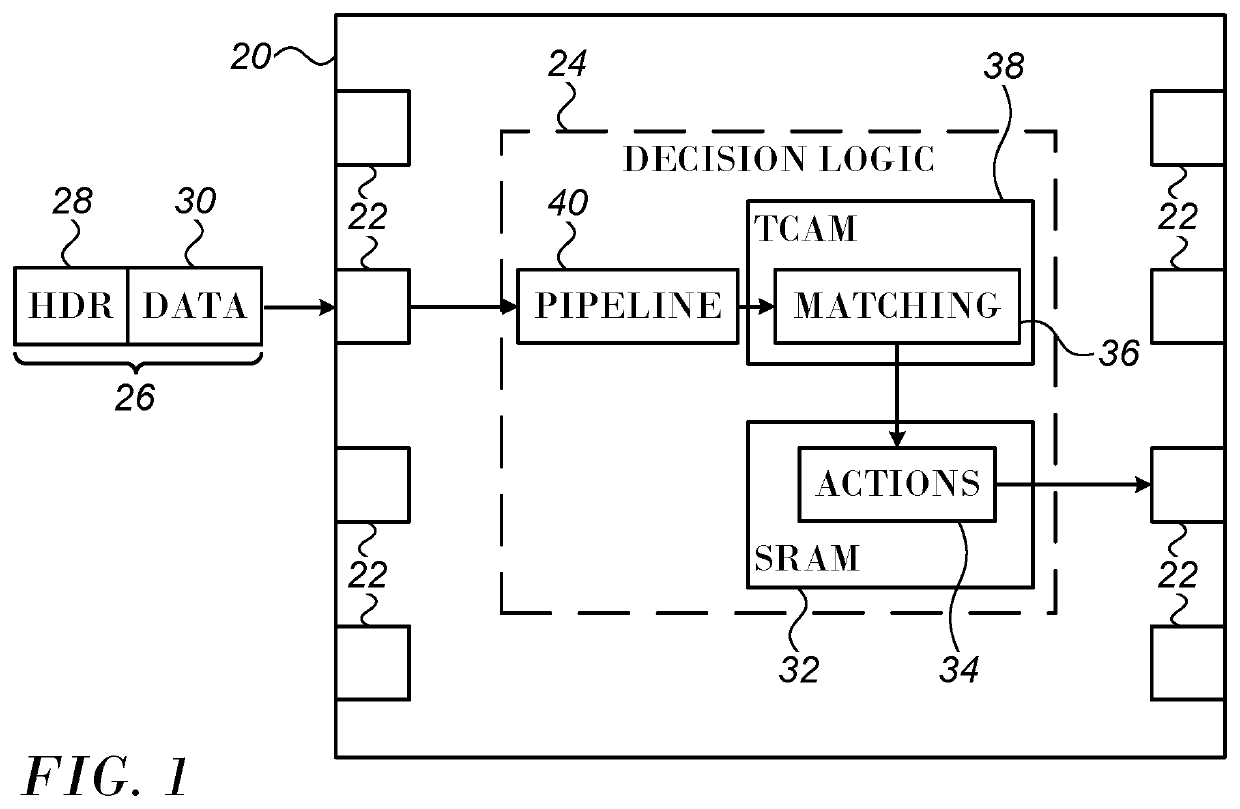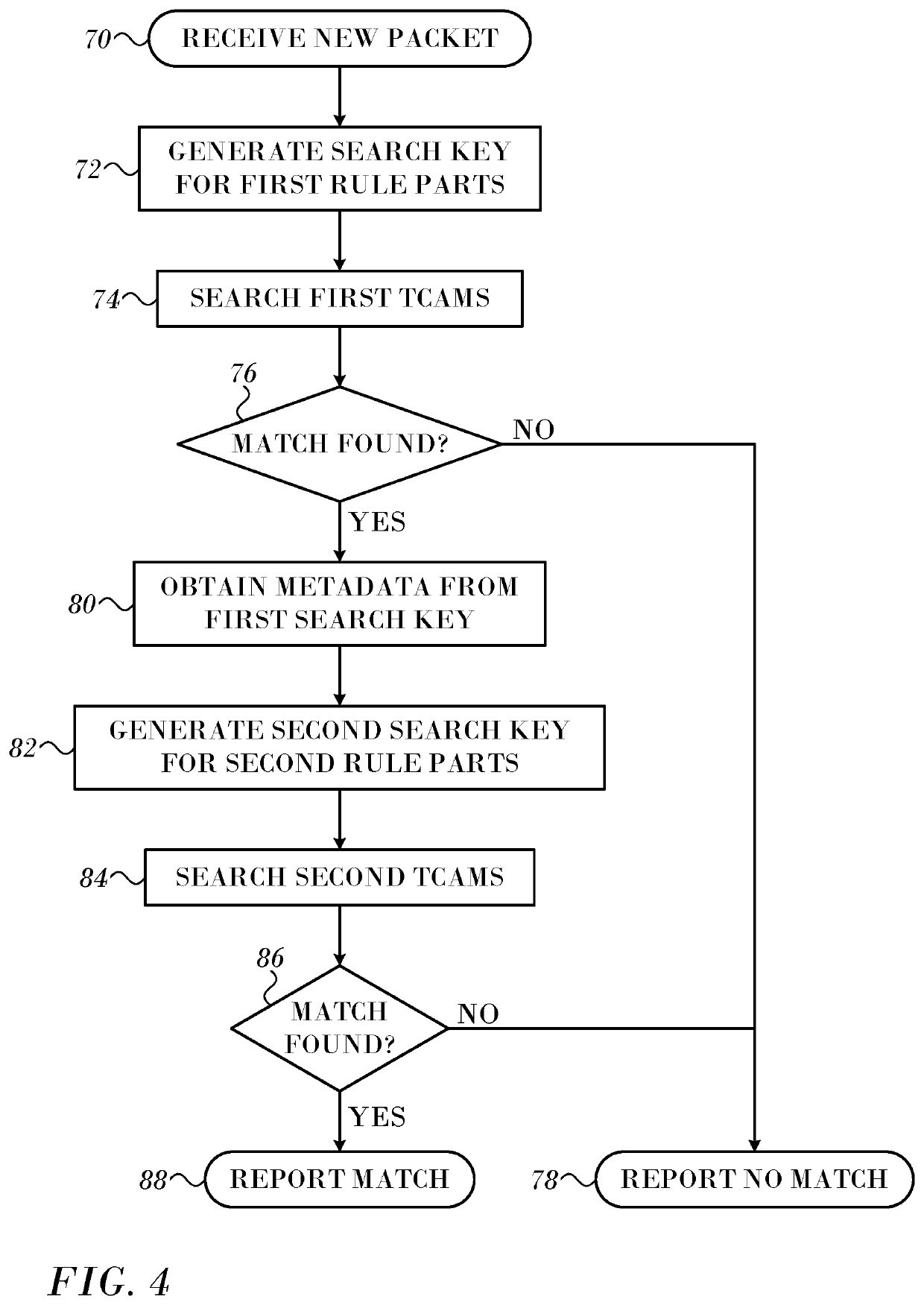Field Variability based TCAM Splitting
- Summary
- Abstract
- Description
- Claims
- Application Information
AI Technical Summary
Benefits of technology
Problems solved by technology
Method used
Image
Examples
first embodiment
[0028]FIG. 2 is a flow chart of a method for accommodating large search keys in a TCAM in accordance with an embodiment of the invention. The method involves splitting a search key into at least two portions in accordance and storing the portions in different TCAMs. While a division of a key into two keys is discussed here for clarity, the method can be generalized to accommodate a larger number of divisions of a key, and the details will be apparent to those skilled in the art. In initial step 42 it is assumed that a rule set is available. The fields of a search are identified. For purposes of this disclosure a field may comprise one or more bits, which are assigned particular meanings.
[0029]Simply splitting the key into two keys is unsatisfactory. To see why, let us assume that we split each key in two parts k={A,B} and do a lookup first on a first part (A) and then on a second part (B). The result of the lookup on the first part is then appended to the lookup on the second part t...
example 1
[0030]Consider a database with five rules:[0031]r1={A1,B1}[0032]r2={A2,B2}[0033]r3={A3,B3}[0034]r4={A4,B4}[0035]r5={A4,B5}
[0036]Then a first TCAM, stores first parts (A):[0037]A1→M1 [0038]A2→M2 [0039]A3→M3 [0040]A4→M4
[0041]Metadata Mi is appended to the second parts Bi for the second lookup, so that the second TCAM or TCAM array has the following entries:[0042]{M1,B1}[0043]{M2,B2}[0044]{M3,B3}[0045]{M4,B4}[0046]{M4,B5}
[0047]In total, there are nine rules, each smaller than the corresponding original rules. It should be noted that the last two rules (r4, r5) share the same first parts and hence the same metadata M4.
[0048]The first lookup on part A gives us metadata M, i.e., data derived from part A according to some prearranged scheme, on which to build a key for the second lookup. This scheme only works if none of the parts A overlap. Two rules overlap when there are keys that match both rules.
[0049]For example, let us consider rules that have only two fields, the source and destin...
second embodiment
[0081]The inventors have found that an efficient encoding of the metadata M obtained in the first lookup and used for the second part avoids entries for the second part of the key, as metadata can be shared by entries for the second part of the key. One way of achieving such an encoding is to compress the fields of the first part in the metadata. Suppose that the first part is formed by fields F1, F2, . . . , Fn, and that each of them has u1, u2, . . . , un unique values in the rule set. Then, matches with those values can be coded in log2(1+ui) bits (rounded up) leaving one combination for a match with ‘x’. Therefore, in the proposed scheme log2(1+ui) bits are assigned to each field in the metadata M and the values that exist in the set of rules are mapped to the bit combinations.
[0082]The number of bits needed for the metadata will depend on the field variability. The above-described algorithm to select the fields having the lowest variability for the first part of the key also mi...
PUM
 Login to View More
Login to View More Abstract
Description
Claims
Application Information
 Login to View More
Login to View More - R&D
- Intellectual Property
- Life Sciences
- Materials
- Tech Scout
- Unparalleled Data Quality
- Higher Quality Content
- 60% Fewer Hallucinations
Browse by: Latest US Patents, China's latest patents, Technical Efficacy Thesaurus, Application Domain, Technology Topic, Popular Technical Reports.
© 2025 PatSnap. All rights reserved.Legal|Privacy policy|Modern Slavery Act Transparency Statement|Sitemap|About US| Contact US: help@patsnap.com



